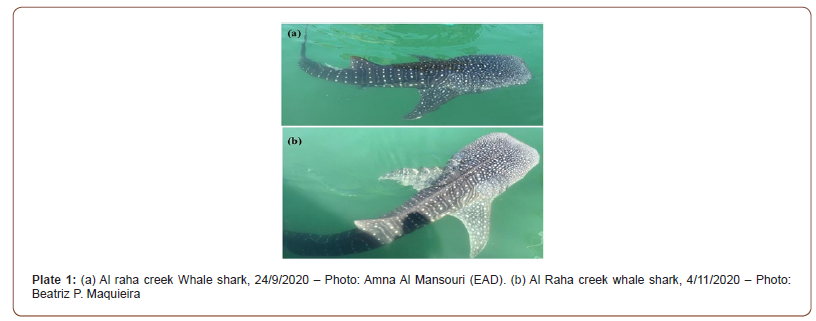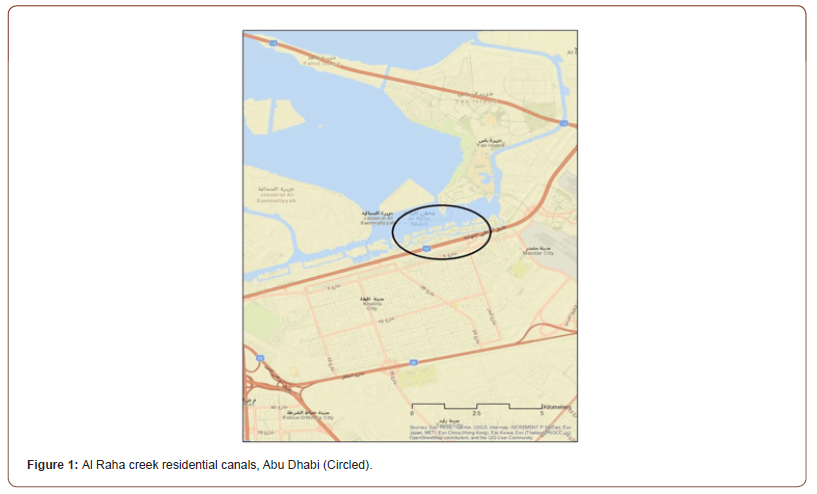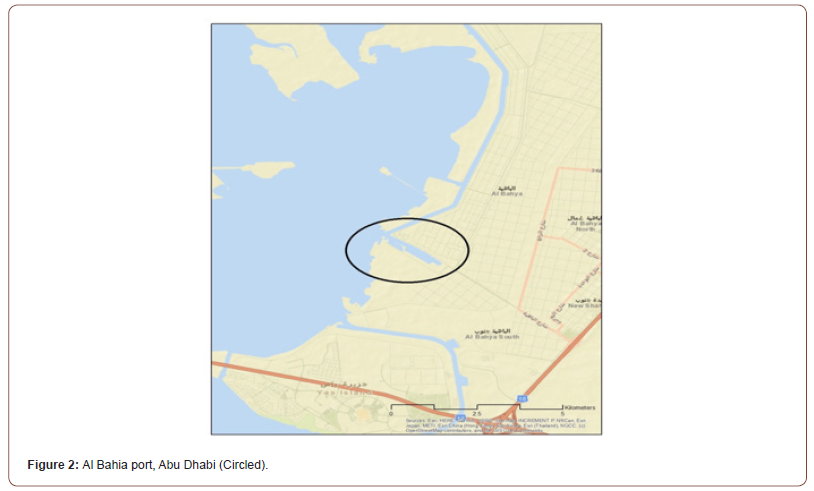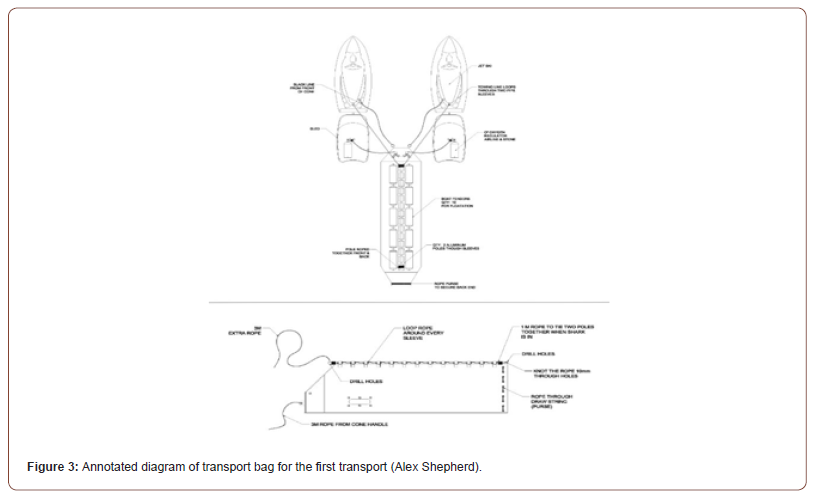 Research Article
Research Article
Notes on the Successful Restraining, Transport, and Release of Two Sub-Adult Whale Sharks (Rhincodon Typus) Stranded Inland on the Coast of Abu Dhabi
Lewis N Cocks*, Simon J Bargielowski, Beatriz P Maquieira and Paul R Hamilton
The National Aquarium, Abu Dhabi, United Arab Emirates
Lewis N Cocks, The National Aquarium, Abu Dhabi, United Arab Emirates
Received Date: March 24, 2021; Published Date: August 16, 2021
Abstract
On November 6th and November 12th, 2020, two sub-adult Whale Sharks (Rhincodon typus) Smith 1828, were successfully restrained and relocated in situ after being stranded for 4 and 2 weeks respectively, in manmade canals inland of Abu Dhabi, UAE. The first relocation operation took ~5 hours to complete a distance of 23.5 km and the second ~3.5 hours for 20km. Both individuals were in good condition after the transportation, with the second R. typus tagged with a SPOT 253 tracker (Wildlife computers).
Keywords: Whale Shark, Elasmobranch, Transport, Orectolobiforms, Tagging, Rescue, Abu Dhabi
Introduction
The Whale Shark, Rhincodon typus [1] is the world’s largest fish and as of 2016 has been classified as Endangered on the IUCN red list [2]. There is currently no action recovery plan in place for this species [3] and relatively little is known about the biology of the R.typus with the vast majority of published research on whale sharks to date being purely observational [4]. Tropical and warm temperate seas throughout are distributed with Whale Sharks [5]. This includes the Arabian Gulf, which is on the warmer scale of its range. During the boreal summer months (April-October), researchers find large aggregations of R. typus in the Arabian Gulf, especially off the coast of Qatar in the Al Shaheen fields. A study identified 340 whale sharks from this site since 2011, indicating that the area is a globally significant feeding area [6]. The same study also highlighted 43 whale shark encounters from UAE waters. Researchers reported twelve encounters from inside the Arabian Gulf side coast of the UAE. Additionally, marinas and ports reported all but three of these sharks [6].
On September 23, 2020, people observed a sub-adult male whale shark with an estimated total length of 4-5 m swimming in the manmade residential canals of the Al Raha creek, Abu Dhabi (Figure 1). The Environmental agency of Abu Dhabi (EAD) halted all boating and recreational activity within the area, and daily observation of the animal began. After several weeks of observation, it was clear that the whale shark had developed a consistent swimming pattern around the canals, and was clearly losing mass, which was the likely result of lack of food source within these shallow waters. Notably, the individual had become paler and has lost several remoras (Remora remora), which were present on first sighting (Highlighted in Plate 1).
After an unsuccessful attempt to guide the whale shark out of the canal using SCUBA divers to enable the shark to swim towards the larger waters, EAD decided a relocation attempt to deeper waters would help enable the shark to resume its natural migration and feeding behavior

Coincidently, on October 30, 2020, a slightly larger (~6m) male shark was observed inside another man-made port in the Al Bahia region of Abu Dhabi (Figure 2). The Al Bahia port that had a narrow entrance and very strong tidal pull during high tide had trapped a second larger Whale shark in it. In a similar manner to the first whale shark, SCUBA divers attempted a rescue mission to relieve the shark from the port. Although successful, the Whale shark returned two days later in the lagoon. This is likely due to the strong tidal pull during high tide.
Methods and Materials
Both R. typus sharks were trapped in relatively shallow water (<5m). This enabled regular observational opportunities multiple times a day, which helped monitor their location and consistent swimming patterns. This in turn helped in monitoring their swimming patterns that they developed whilst in the manmade canals. The capture of both individuals was successful on first attempt. Teams of four SCUBA divers followed several meters behind the transport bag. When the Whale shark swam towards the transport bag the team of SCUBA divers, guided the shark directly into the bag, later swiftly securing it.
The transport bag shown in Figure 3 & 4 was custom designed for the rescue operation. For the fabrication of the main body of the bag, they used clear PVC, with nylon straps, 4500 mm aluminum poles and a nylon mesh cone to allow water to pass through. In total, the transport bag was 5000 mm long, with the cone section measuring 1000 mm in length. The bag has 10x Polyform F-3 Fenders to suspend the bag on the surface of the water.



Once the R. typus individual was inside the bag, the pectoral fins were place through gaps in the bag measuring 4700 mm x 1500 mm. 9mm marine grade nylon rope secures the poles and the bag. For the first transport, divers towed the transport bag via four 9mm nylon towlines attached to two Yamaha FX Cruiser 1800 Jet Skis. Each Jet Ski towed two lines, one attached directly to the poles and one from the nylon cone handle as show in Figure 3. Each Jet Ski was equipped with a liquid shredder sled, which carried a 10-liter oxygen cylinder delivering medical grade oxygen via 4/6 mm airline tubing and a porous air stone, secured inside the cone of the bag, which was to assist the delivery of dissolved oxygen to the Whale shark during the transport.
For the transportation of the second R. typus, the divers made some adjustments and enhancements to the same transport bag (Figure 4). The Key changes include the addition of foam spacers along the aluminum poles to help protect the dorsal fin as well as a rigid PVC pipe inside the cone to help strengthen the bag structure when not under tension. Finally, they consolidated four towlines to a master point consisting of stainless-steel carabiners and a stainless-steel shackle. From the shackle master point, they used a 3000mm x 750 mm nylon-lifting sling to tow the bag, using a single jet ski. This amended configuration also required a steel spacer bar on the cone head to ensure it did not collapse, reducing water flow. The single Jet Ski arrangement enhanced maneuverability in comparison to the original configuration as well as higher tensile strength with the addition of the lifting sling. During both transportation journeys, divers stationed on the tow jet skis monitored the towlines and oxygen supply. Periodically, support jet skis deployed SCUBA divers ~100 m ahead of the moving transport bag in order to visually check the health of the animal and inspect the transportation set up. Support vessels remained close by during the entire operations, assisting where necessary. Upon the release of the second R. typus, they successfully anchored a SPOT 253 (wildlife computers) satellite transmitter to the individual using a handheld swobbit-tagging pole.
Discussion and Conclusion
Capturing and transportation of Elasmobranchs successfully has been widely demonstrated throughout various applications such as for captivity, scientific research or wildlife management. Aside from the R. typus, Elasmobranchs of the orectolobiformes order (Carpet sharks) such as the Atlantic nurse shark (Ginglymostoma cirratum), are routinely captured and released without too much impact as demonstrated by Aucoin et al, 2017. However, due the sheer size and lack of captivity feasibility, there is little knowledge on the effects or methods of transporting R. typus. Dove et al, 2011 noted the acquisition of several R. typus for the Georgia aquarium, which demonstrated successful transport techniques for commercial flight operations. The process highlights the use of vinyl stretchers, a proven material for Elasmobranchs transports, but the situation itself is quite dissimilar to the in situ relocation process highlighted within this paper.
The ultimate aim of the relocation process for the two R. typus was to ensure the animals could return to the open Arabian Gulf and resume their natural migration patterns. This meant that the transportation of the whale sharks had to ensure they arrived in optimal health. The key concerns considered for the operations were to guarantee their safety and security for the entirety of the journey, and that they were receiving enough dissolved oxygen (DO). Fishes consume up to three times their normal oxygen requirement under transport conditions. Exhausted fishes may consume as much as 5-10 times their normal requirement [1,7,8]. The greater a commitment to aerobic respiration, the more important an unimpeded oxygen supply [1,7].
As highlighted in Figures 3 & 4, the transportation bag incorporates a nylon mesh front to allow the passage of new water during the towing of the bag. Simultaneously, this mesh also acted as a barrier for the turbulent and foamy water caused from the Jet Ski propulsion. During the first transport of the Al Raha creek individual, the oxygen supply line, secured only at the porous air stone, came undone from the force of the water drag. However, after continuous observations, the respiration rate of the whale shark did not drastically changed, and the operation continued without the supplementation of DO. Other minor complications during the first transport included the snapping of one of the towline. Because the transportation set up utilized two jet skis, it required both vehicles to accelerate equally, in order to achieve equal tension. Due to some minor turns and water currents, it was not always possible to have equal propulsion, which eventually led to the excess strain on the lines leading to ultimately broking them. Retying the snapped towlines led to more unequal line lengths, thus further hindering the efficiency of the journey, with several stops needed to check and adjust the lines.
The upgrades shown in Figure 4 for the transport of the second R. typus, allowed for a much smoother journey, with the abovementioned issues now becoming obsolete. DO was also delivered for a much longer period with the airline tubing secured in multiple stages along the lifting sling. The minor draw back from the amended configuration of the second transport was the need to change and refuel the single tow jet ski. However, this was not overly time consuming and allowed a thorough check of the condition of the R. typus. In total, the first transport operation that took place on November 6, 2020 lasted approximately 5 hours from acquisition to release, over a total distance of around 23.5km as highlighted in Figure 5. The whale shark dived immediately to the deeper water heading into the direction of the open Arabian Gulf.

Within 48 hours of the release of the first Whale Shark, it returned to the original location of the inland residential canals in Al Raha creek. They confirmed the same animal by comparison of its spot pattern. This is a very surprising piece of information. Firstly, this observation confirmed the method of relocation of a sub adult whale shark was feasible for survivorship. Secondly, this circumstance may have some significance in understanding how R. typus migration and swimming patterns occur. The likelihood for this animal to return over 23km back to such an undesirable and exact location in such a short time frame suggested its occurrence in the area was not purely accidental, but potentially influenced by external and/or environmental factors. After a further 48 hours, the individual disappeared again.
On November 12, 2020, the second transport from Al Bahia port was slightly shorter at ~20 km (Figure 5). Despite a similar distance travelled to reach an open approach to the Arabian Gulf, the operation was more efficient due to the amendments of the transport hardware and configuration. After a total time of ~3.5 hours, the authorities released the whale shark. Prior to release, they successfully tagged the animal and received the first signal the next day. The whale shark swam in north and northeast direction to the location 190 km away from the release point within one week. Then the shark remained in the border waters among Qatar, UAE and Iran for more than three weeks. Over the first 30 days (13/12/2020), it travelled 601 km (Figure 6).


Looking at both transport operations of the two sub-adult Whale Sharks (R. typus), it can be noted with confidence that the methodology, strategy and materials used for the relocations resulted in successful transfers in terms of animal health postrelease. The visual observation from the first R. typus showed that the animal was in good physical condition aside from the loss of mass sustained prior the transport. The data received via the satellite transmission post release of the second whale shark, showed that the animal survived the transportation and returned to normal R. typus swimming and migration behavior within the Arabian Gulf. The return of the first whale shark to its original location after the transport operation is extremely surprising, and unfortunate. However, it is noteworthy information, which may suggest that the influence of external factors on the migration of the R. typus towards its destination.
On a final note, the transportation materials used suited the slightly larger ~6m whale shark, which was more stable and secure during the operation. The up or down extrapolation of the dimensions of the highlighted materials is achieved depending on the animal in question, in the event of a similar situation.
Acknowledgements
We thank all the parties involved in the operations. Our special thank you to Winston Cowie, Maitha Al Hameli and Hamad Al Jailani from the Abu Dhabi Environment Agency who put in continuous effort to monitor both of the Whale sharks right up until the day of transport. In addition, we want to thank Alistair and the crew at Abu Dhabi Marine for the vessel support, Jet Ski team and various marine supplies. A special thank you to the National Aquarium employees for their active roles on the various operations, The Media team, Islam Yassin and Anas Allwama for the drone support which proved vital for the tracking of the Whale sharks. We also appreciate Alex Shepherd for supplying the AutoCad drawings for the Methods and Materials section and finally Hsu Hua Hsun from King Fahd University of Petroleum and Minerals for providing the SPOT tag at short notice.
Conflict of Interest
None.
References
- Smith M, Warmolts D, Thoney D, Hueter R (2004) The Elasmobranch Husbandry Manual: Captive Care of Sharks, Rays and their Relatives. In: Smith M, Warmolts D, Thoney D, Hueter R. The Elasmobranch Husbandry Manual: Captive Care of Sharks, Rays and their Relatives. Editors Special Publication of the Ohio Biological Survey, p. 589.
- Pierce SJ and Norman B (2016) Rhincodon typus. The IUCN Red List of Threatened Species: e.T19488A2365291.
- IUCN (2020) The IUCN Red List of Threatened Species. Version 2020-3.
- Dove ADM, Coco C, Binder T, Schreiber C, Davis R, et al. (2011) Acquisition, husbandry and veterinary care of whale sharks in a public aquarium setting. In: Health and Diseases of Aquatic Organisms: Bilateral Perspectives (R. Cipriano and I. Schelkunov eds). Proceedings of the 3rd US/Russian Bilateral Exchange on Aquatic Animal Health. MSU Press: East Lansing Michigan: pp. 251-258.
- Compagno LJV (2001) Sharks of the world: An annotated and illustrated catalogue of shark species known to date, Vol. 2. Bullhead, carpet and mackerel sharks (Heterodontiformes, Lamniformes and Orectolobiformes). FAO species catalogue for fisheries purposes: 186–209.
- Robinson DP, Jaidah MY, Bach S, Lee K, Jabado RW, et al. (2016) Population Structure, Abundance and Movement of Whale Sharks in the Arabian Gulf and the Gulf of Oman. PLoS ONE 11(6): e0158593.
- Wardle CS (1981) Physiological stress in captive fish. In: AD Hawkins (edt). Aquarium Systems. Academic Press, Harcourt Brace Jovanovich, London, England, pp. 403-414.
- Froese R (1988) Relationship between body weight and loading densities in fish transport using the plastic bag method. Aquaculture and Fisheries Management 19(3): 275-281.
- Aucoin S, Weege S, Toebe M, Geurtin J, Gorham J, et al. (2017) A new underwater shark capture method used by divers to catch and release nurse sharks (Ginglymostoma cirratum). Fishery Bulletin 115(4): 484-495.
-
Lewis N Cocks, Simon J Bargielowski, Beatriz P Maquieira, Paul R Hamilton. Notes on the Successful Restraining, Transport, and Release of Two Sub-Adult Whale Sharks (Rhincodon Typus) Stranded Inland on the Coast of Abu Dhabi. Ad Oceanogr & Marine Biol. 2(5): 2021. AOMB.MS.ID.000548.
-
Whale shark, Elasmobranch, Transport, Orectolobiforms, Tagging, Rescue, Abu dhabi
-

This work is licensed under a Creative Commons Attribution-NonCommercial 4.0 International License.






